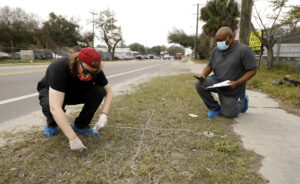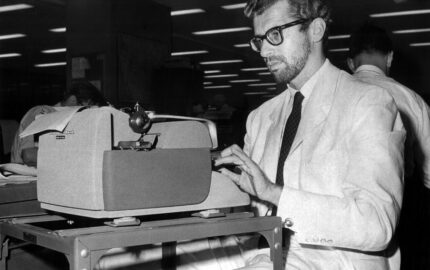Cambridge, Mass. – “Poisoned,” a meticulously researched series by The Tampa Bay Times that revealed dangerous working conditions inside the Gopher Resource lead smelting plant in Tampa, Florida, is the winner of the 2021 Worth Bingham Prize for Investigative Journalism.
The series was produced by investigative reporters Corey G. Johnson, Rebecca Woolington and Eli Murray. They revealed that hundreds of employees, many of whom were Black and immigrants, regularly worked in clouds of poisonous lead dust and other toxic chemicals with respirators that did not adequately protect them from fumes.
Despite knowing about the problem, Gopher for years failed to fix the factory’s faulty ventilation system and its company doctor didn't warn workers that the amount of metal in their blood put them at risk for serious health problems.

The series also showed that lead levels in the air inside the plant — where lead is extracted from used car batteries, melted and then resold as blocks of metal — was hundreds of times higher than what is allowed by the federal government. Workers unwittingly carried lead home, exposing their children to the neurotoxin.
The reporters discovered that federal regulators from OSHA hadn’t been inside the Gopher facility in five years and they hadn’t specifically investigated lead issues inside the factory since 2014. In years prior, OSHA had notified the factory before site visits, giving the company time to clean up. OSHA inspectors had also tested for the wrong chemical after workers complained about high gas exposure.
The reporters also pointed out that while OSHA permits workers to have as much as 60 micrograms of lead per deciliter of blood, that range was established 42 years ago. New data shows that health effects can happen from lead at far lower levels.
When the first stories ran in March 2021, the Times mailed the series to 2,000 nearby residents to reach people most at risk. Later, the paper also discovered that Gopher and regulators mishandled the cancer-causing metal cadmium.

The reporters documented how the factory polluted the community’s air, soil and water and how the company tried to limit emissions when it knew county monitoring devices were turned on to measure air quality.
To increase their understanding of the topic, all three reporters became certified lead inspectors. They interviewed more than 100 workers and 65 expert sources and reviewed more than 100,000 pages of documents, including personal medical records, confidential company emails, engineering studies and consultant reports that regulators had never seen. They built databases showing the scope of worker contamination, including air-lead levels inside the factory from 2007 to 2021. And they obtained blood-lead tests for more than 500 workers and compared their average lead levels to those associated with long-term health risks in research papers.
Bingham Prize judge Margie Mason said: “The series is reminiscent of reporting often seen in developing countries where very few, if any, health and environmental regulations exist. The work the reporters devoted to building a database from current and former workers’ health records, and the care and skill that went into the writing, plus the impact, place it in a category of true public service. When the reporters hit roadblocks, they dug in and worked to find ways around them. They reported and reported and reported some more — and it shows.”

The Tampa Bay Times completed “Poisoned” with support from PBS Frontline’s Local Journalism Initiative, which provided partial funding and consultation. Several Gopher workers provided vital photos and videos of conditions inside the plant, which as a private company was off limits to the Times staff.
The series has led to important reforms. Before the stories ran, Gopher began making changes in response to reporters’ questions, including repairing problems with the factory’s ventilation system, which had been identified at least four years earlier.
After the first articles were published, a team of OSHA inspectors visited the plant and verified the Times’ findings. They ordered additional improvements and issued $319,000 in fines, one of the highest penalties in Florida in recent years. In January 2022, Gopher faced $518,000 in additional fines following a two-month inspection by local regulators from the Hillsborough County Environmental Protection Commission. If approved, the county penalty against Gopher will be the largest imposed in the history of the Commission.
Other outcomes:
- A bond rating firm downgraded Gopher’s credit.
- Neighborhood children were screened for lead exposure.
- Regulators ordered random air testing to prevent Gopher from manipulating its emissions.
- A former worker sued the company on behalf of his lead-poisoned child.
- Gopher and the company doctor changed their practices after the Times asked about the lack of required follow-up provided to workers exposed to cadmium.
- Lawmakers and public health officials referenced the series when calling on the federal government to lower acceptable lead limits at workplaces across the country.
Bingham Prize judge Robin McDowell said: “The Tampa Bay Times’ ‘Poisoned’ is mind-bogglingly great investigative reporting. Located in Tampa, and just a half mile from an elementary school, Gopher Resources supplied the U.S. military and ammunition makers, among others. Again and again, the reporters exposed ways in which the company — and regulators — failed workers, their children and the community at large, mostly people of color. The reporters were relentless in their pursuit of the truth. They exposed how company officials not only knew they were putting lives at risk, but intentionally interfered in the work of regulators, who were themselves shockingly negligent. Not surprisingly, the impact of this great work was tremendous and swift, including reforms and hundreds of thousands of dollars in penalties.”
The seven journalists who judged the Bingham submissions this year are Associated Press investigative reporters Margie Mason (a 2009 Nieman Fellow) and Robin McDowell, who together won the 2020 Bingham Prize for their AP series “Fruits of Labor”; John Archibald, a columnist for al.com and its papers and a 2021 Nieman Fellow; Aaron Eaton, associate digital line producer at KYW-TV in Philadelphia and a 2021 Nieman Visiting Fellow; Christine Willmsen, investigations editor at WBUR and a 2016 Nieman Fellow; Kyle Edwards, a journalist, 2021 Nieman Visiting Fellow and current Stegner Writing Fellow at Stanford University; and Scott Dance, an environment reporter for The Baltimore Sun and a 2021 Abrams Nieman Fellow for Local Investigative Journalism.
The $20,000 Worth Bingham Prize for Investigative Journalism honors investigative reporting of stories of national significance where the public interest is being ill-served. It is presented annually by the Nieman Foundation for Journalism at Harvard University. Worth Bingham, who died at the age of 34, achieved prominence as an investigative journalist and was vice president and assistant to the publisher for the Louisville Courier-Journal. He was a 1954 Harvard University graduate. His family and friends created the annual prize in his memory in 1967.
The Nieman Foundation for Journalism at Harvard educates leaders in journalism and elevates the standards of the profession through special programs that convene scholars and experts in all fields. More than 1,600 journalists from 99 countries have been awarded Nieman Fellowships since 1938. The foundation’s other initiatives include Nieman Reports, a website and print magazine that covers thought leadership in journalism; Nieman Lab, a website that reports on the future of news, innovation and best practices in the digital media age; and Nieman Storyboard, a website that showcases exceptional narrative journalism and explores the future of nonfiction storytelling.



